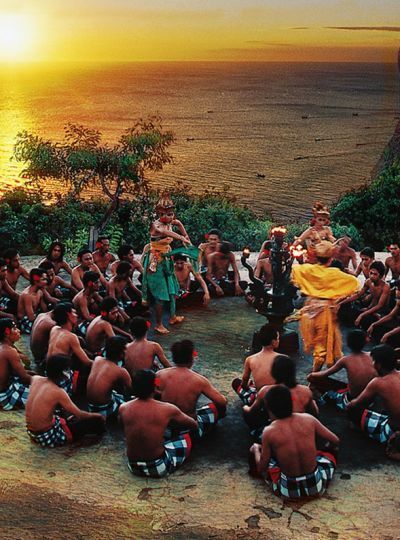Cultura Balinesa
La Isla de los Dioses
La cultura balinesa es compleja, una combinación única de espiritualidad, religión, tradición y arte. Los antropólogos creen que los balineses descienden de los antiguos chinos, indios y árabes del oeste, además de otros pueblos que llegaron directamente o a través de Java.
Introducida en el siglo I d.C., la cultura hindú aún impregna toda la vida balinesa, ofreciendo un calendario continuo de festivales y ceremonias durante todo el año, además de proporcionar un orden estructurado a la sociedad balinesa. En cualquier parte de Bali, podrá maravillarse con los vibrantes colores de los trajes de batik, las ofrendas de flores y frutas, y la multitud de templos ricamente tallados dedicados a un panteón de dioses. La celebración del ciclo de nacimiento, muerte y renacimiento es constante, así como los rituales de matrimonio, infancia y culto a los antepasados, junto con otros muchos eventos importantes de la vida y la comunidad.
El arte tradicional balinés es una extensión de la religión hindú de Bali, con todas sus antiguas formas artísticas inspiradas en las sagradas escrituras del Ramayana y el Mahabharata. La isla cuenta con una rica tradición de artesanos y es famosa por sus tallas de madera, pinturas, orfebrería en oro y plata, telas de batik, danzas y teatro. En las décadas de 1930 y 1940, hubo un auge creativo en el arte balinés, especialmente en la pintura y la talla en madera, influenciado en gran parte por el arte occidental.
Bali es una sociedad patriarcal, donde la familia es la unidad básica. Antiguamente, un sistema de castas hindúes determinaba estrictamente la interacción social. Hoy en día, la distinción de castas tiene una menor importancia en la sociedad moderna de Bali, donde la educación y el desarrollo personal están abiertos a todos. Sin embargo, el respeto por los orígenes familiares sigue siendo fundamental en las relaciones sociales. La primera pregunta al conocer a alguien sirve para identificar su casta y, en consecuencia, la forma de dirigirse a él. Mientras que en el pasado el matrimonio entre castas era castigado con la muerte, hoy en día es ampliamente aceptado.


